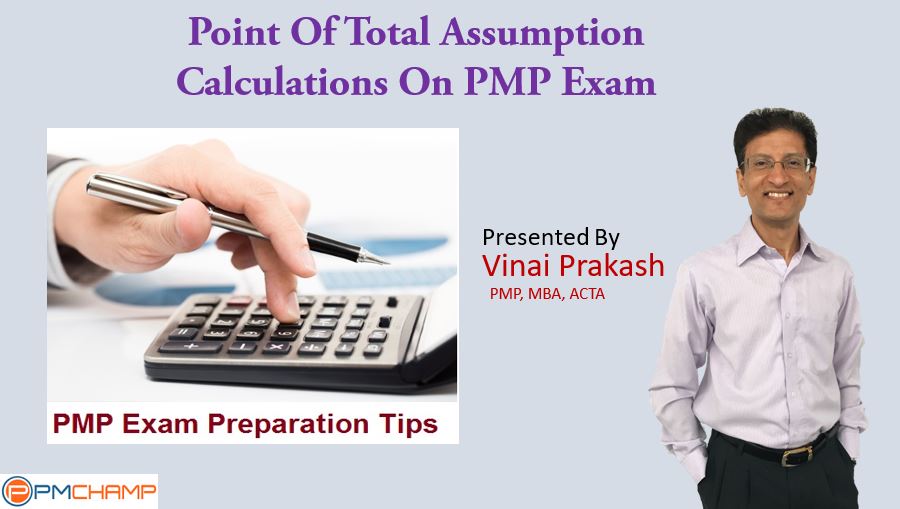Some time back, we covered the Cost Plus Incentive Fee Type of Contract Calculations, which is a “must know” for the PMP exam.
 Also watch the video on How to Answer Contract Type Questions for PMP exam.
Also watch the video on How to Answer Contract Type Questions for PMP exam.
In the recent past, there have been many questions coming from a relatively unknown term – Point of Total Assumption (PTA) on the PMP Exam.
Surprisingly, the Point of Total Assumption does not even appear in the PMBOK Guide, Sixth Edition. Yet, questions using the Fixed Price Incentive Fee (FPIF) contract type often refer to this term.
To understand the PTA, you must first have a good understanding of the Fixed Price Incentive Fee Contract. In this contract, the buyer agrees to pay a fixed price, and a maximum price for cost overruns. This is called the Most Pessimistic View of Costs. Beyond this point, if the cost rises, it will most likely be because of mis-management at the Seller’s end, thus, the seller has to bear all the extra costs beyond this point.
Any FPIF contract specifies a target cost, a target profit, a target price, a ceiling price, and one or more of the sharing ratios. The PTA is the difference between the ceiling and target prices, divided by the buyer’s portion of the share ratio for that price range, plus the target cost.
PTA = ((Ceiling Price – Target Price) / Buyer’s Share Ratio) + Target Cost
If, however, the seller finishes work at lower cost, there is an incentive, and this maximizes the Seller’s gains.
Let’s take an example:
Target Cost: 1,000,000
Target Profit for Seller: 100,000
Target Price: 1,100,000 (Target Cost + Profit for Seller)
Ceiling Price: 1,300,000 ( the maximum the buyer will pay)
Share Ratio: 80% buyer–20% seller for over-runs, 50%–50% for under-runs.
PTA = ((1,300,000 – 1,100,000)/ 0.80) + 1,000,000 = 1,250,000.
Beyond the Point of Total Assumption, the seller’s profitability decreases, and their initiative and interest to complete the project may diminish too. Therefore, the PTA is also a risk trigger. As this point is reached, the project risk increases, and more attention is needed to complete the project at the earliest, with as little cost deviation as possible.
In a real project, the Budget at Completion (BAC) should be controlled as closely as possible, and it is best to keep it under the PTA.
This Point of Total Assumption does not come up in a Cost Reimbursable Contract, because in a Cost Plus type of contract, the buyer agrees to pay off all the cost.
It is very important that you understand this concept of the PTA for the PMP exam, as it has appeared for many, although it did not appear in my PMP exam… but that was years ago 🙂
All the Best!
Cheers,
Vinai Prakash


>>Beyond the Point of Total Assumption, the seller’s profitability decreases, and their initiative and interest to complete the project may diminish too. <<
The seller's profitability decreases right from the first dollar (or whatever currency unit) of cost overrun, as the buyer only pays a part of the additional actual costs. They seller's share decreases profitability.
hi hemmu,
this was also confusing to me, the way I understood it is,
if Actual cost >PTA ,then Actual Cost + profits for seller > Ceiling price. so if the cost was beyond the PTA, then contractor will break the cost ceiling and lose 100% of the cost that’s above this ceiling.
for example let’s look at 2 scenarios:
scenario A:
-assume in the example above, the actual cost is 1,251,000 (>than PTA by 1,000 USD)
-the seller should bare 20% of the difference between target cost and AC . so :
(target cost-AC) *portion of seller= reduction or increase in profit
(1,000,000- 1,251,000) 20%= -50,200
-the seller’s profit is now reduced by 50,200 and they are supposed to be paid Actual cost+adjusted profits.
1,251,000+(100,000-50,200)= 1,300,800
-however the price ceiling is 1,300,000 so the buyer will only pay 1.3Million and the seller will have to bare the extra 800 USD cost.
Scenario B:
-if actual cost = 1,249,500 (<PTA by 500USD)
-then the seller's loss of profit = (1,000,000-1249,500)* 20%
=249,500*20%=-49,900
-so the buyer should pay 1,249,500+50,100=1,299,600 (<ceiling price)
I hope that makes sense.
HI can you explain in which circumstances in fixed price contract does seller disclose his her profit?
If you disclose your cost and your profit/profit component its no longer a fixed price.
in your example
Target Cost: 1,000,000
Target Profit for Seller: 100,000
Target Price: 1,100,000 (Target Cost + Profit for Seller)
What will be signed contract amount?
Manish, Its a fixed price incentive fee type contract. Probably you are carried away with the wrong notion of ‘Fixed fee” alone.
Hi manish,
regarding why you would disclose your profit, you may wish to follow the cost plus incentive if your costs are highly volatile but known.
-Let’s say the business model is to buy raw petroleum and purify it ,then sell it, and the client wants 5 tons next year.
– contractors don’t want to offer fixed price out of fear that the cost might go up next year by the delivery time.
-the cost of raw petroleum is known in the market, and the profits /markup is also pretty known (industry knowledge) so in this case contractor can quote the client “cost +x” or cost +x%) .
-contractor bares some of the risk of the price increasing by accepting a maximum Ceiling price (which is fair because the contractor with industry experience should have a view on future costs)
-if the contractor has very high operating cost due to bad management of the purification process or technical difficulties he is penalized by having to bare part of the cost increase. so contractor bares X% of any cost above the Target price and 100% of any cost above the ceiling price.
hope that answers your question.